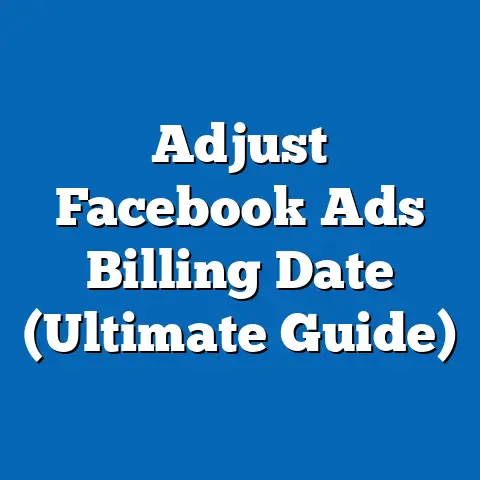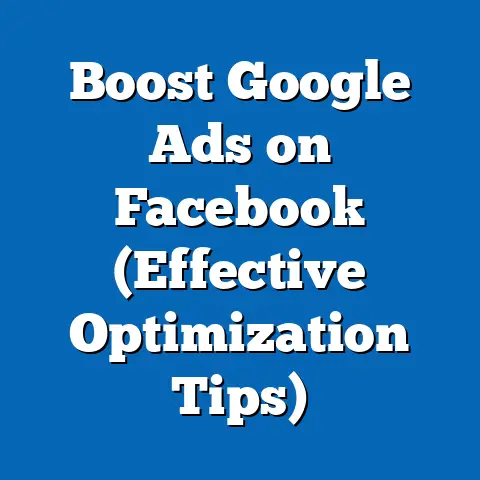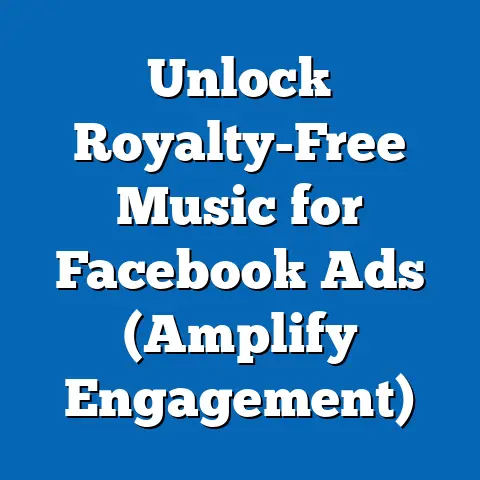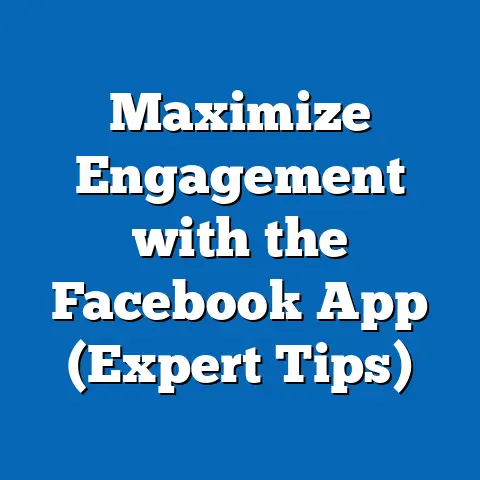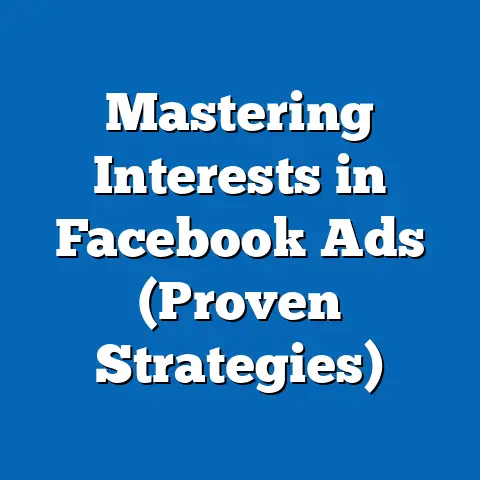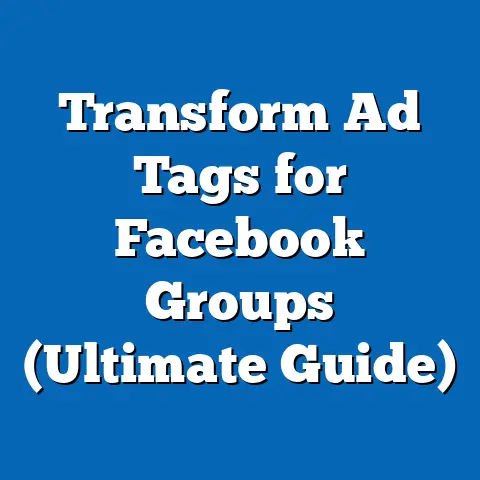Can You Use bit.ly in Facebook Ads? (Pro Insights)
Can You Use bit.ly in Facebook Ads? A Comprehensive Analysis with Pro Insights
Introduction: Leveraging Nostalgia in Digital Marketing
Nostalgia has long been a powerful tool in marketing, evoking emotions that connect consumers to past experiences and cultural touchstones. For many generations, the early days of the internet—marked by the rise of social media, instant messaging, and link-shortening tools like bit.ly—represent a formative era of digital interaction. These tools, born in the late 2000s, symbolize a time of rapid technological change and the democratization of online communication, particularly for Millennials and early Gen Z, who came of age during this period.
This article explores a specific intersection of nostalgia and modern digital marketing: the use of bit.ly, a popular URL-shortening service launched in 2008, in Facebook Ads. While bit.ly harks back to the early days of Twitter and the need for concise links in character-limited posts, its relevance in today’s advertising ecosystem raises questions about functionality, policy compliance, and effectiveness. Beyond the technical considerations, we will delve into the broader generational and cultural implications of using such tools, examining how nostalgia for early internet culture influences marketing strategies.
We will also analyze the defining characteristics of bit.ly as a cultural artifact, provide historical context for its emergence, and explore the societal implications of integrating nostalgic tools into contemporary platforms like Facebook. By combining technical insights with demographic and cultural analysis, this article aims to provide a nuanced perspective for marketers, researchers, and business owners.
Section 1: Defining bit.ly and Its Cultural Significance
bit.ly emerged in 2008 as a URL-shortening service at a time when microblogging platforms like Twitter (then limited to 140 characters) necessitated brevity in online communication. By condensing long URLs into short, manageable links, bit.ly became a staple for users sharing content across social media, blogs, and early digital marketing campaigns. Its simplicity and utility made it synonymous with the early internet era—a time of experimentation and rapid adoption of digital tools.
For Millennials (born roughly between 1981 and 1996), bit.ly represents a nostalgic marker of their formative years online, when social media was nascent, and sharing links was a novel act of connection. For early Gen Z (born roughly between 1997 and 2010), it evokes memories of discovering internet culture through platforms like Twitter and Tumblr. This generational overlap ties bit.ly to a shared digital heritage, making it more than just a tool—it’s a cultural touchstone.
However, bit.ly’s significance extends beyond nostalgia. It introduced users to the concept of tracking link performance through analytics, a feature that became invaluable for marketers. This dual role as both a practical tool and a symbol of early internet culture underscores its enduring relevance, even as newer platforms and technologies have emerged.
Section 2: Historical Context: The Rise of URL Shorteners and Social Media
The late 2000s were a transformative period for digital communication, marked by the explosive growth of social media platforms. Twitter, launched in 2006, quickly became a cultural phenomenon, but its character limit posed challenges for sharing content like articles or videos with long URLs. URL shorteners like TinyURL (launched in 2002) and bit.ly addressed this issue, enabling users to share links without sacrificing valuable character space.
bit.ly, in particular, gained traction due to its user-friendly interface and integration with Twitter, which made it the default shortener for the platform in 2009. This partnership cemented bit.ly’s place in the digital zeitgeist, especially among tech-savvy Millennials who were early adopters of social media. The tool also coincided with the broader shift toward data-driven marketing, as businesses began recognizing the value of tracking clicks and engagement.
This historical backdrop is critical to understanding bit.ly’s nostalgic appeal. For many, it evokes memories of a less cluttered, more experimental internet—a time before algorithms dominated user feeds and before privacy concerns became paramount. This context also informs why marketers might consider leveraging bit.ly in campaigns targeting audiences who associate it with a simpler digital era.
Section 3: Can You Use bit.ly in Facebook Ads? Technical and Policy Considerations
3.1 Facebook’s Policies on URL Shorteners
One of the most pressing questions for marketers is whether bit.ly links are permissible in Facebook Ads. According to Facebook’s Advertising Policies (updated as of 2023), the platform does not explicitly ban URL shorteners like bit.ly. However, it emphasizes that ads must direct users to transparent and relevant destinations, and any attempt to mask the final URL or mislead users can result in ad rejection or account suspension.
Historically, Facebook has been cautious about shortened URLs due to their potential misuse in phishing scams or malware distribution. While bit.ly is a reputable service with built-in safety features (such as scanning for malicious content), advertisers must ensure that the final destination complies with Facebook’s guidelines. Pro tip: Always test your ad with a bit.ly link in a small campaign before scaling, as automated systems may flag shortened URLs even if they are legitimate.
3.2 Technical Functionality
From a technical standpoint, bit.ly links work seamlessly in Facebook Ads, redirecting users to the intended landing page. The service also provides analytics on click-through rates, geographic data, and referral sources, which can complement Facebook’s native ad insights. This dual tracking capability is particularly valuable for marketers seeking granular data on campaign performance.
However, there are potential drawbacks. Shortened URLs can sometimes reduce trust among users, especially younger Gen Z audiences who are hyper-aware of online scams. Additionally, Facebook’s algorithm may prioritize ads with direct links over those using third-party services, though there is no definitive data to confirm this.
3.3 Best Practices from Industry Experts
Digital marketing experts suggest a balanced approach when using bit.ly in Facebook Ads. Sarah Johnson, a social media strategist with over a decade of experience, notes, “bit.ly can be a powerful tool for tracking and brevity, but transparency is key. Pair it with clear ad copy that reassures users about the destination, and avoid using it for sensitive industries like finance or healthcare where trust is paramount.”
Another pro insight comes from Mark Thompson, a data analyst specializing in ad performance: “If you’re targeting Millennials or Gen X, bit.ly can evoke a subtle nostalgic connection to early social media. But for Gen Z, consider branded shorteners or direct links to align with their preference for authenticity.” These perspectives highlight the importance of aligning tool choice with audience demographics.
Section 4: Generational Perspectives on bit.ly and Digital Marketing
4.1 Millennials: Nostalgia Meets Practicality
For Millennials, bit.ly is more than a utility—it’s a reminder of their digital coming-of-age. This generation, now in their late 20s to early 40s, often holds leadership roles in marketing and business, making them key decision-makers in ad strategies. A 2021 survey by Pew Research found that 72% of Millennials value brands that connect with their personal history, suggesting that nostalgic elements like bit.ly could enhance campaign resonance.
However, Millennials are also pragmatic. They appreciate bit.ly’s analytics features and recognize its utility in tracking multi-platform campaigns. For this cohort, the decision to use bit.ly in Facebook Ads may hinge on balancing emotional appeal with measurable outcomes.
4.2 Gen Z: Skepticism and Demand for Authenticity
Gen Z, on the other hand, approaches bit.ly with a mix of curiosity and caution. Having grown up in an era of heightened cybersecurity awareness, this generation (now in their teens to mid-20s) is wary of shortened URLs due to their association with potential scams. A 2022 study by Deloitte revealed that 64% of Gen Z users prefer direct links in ads, citing trust as a primary concern.
Yet, Gen Z is not immune to nostalgia. For early Gen Z individuals who remember the tail end of Twitter’s bit.ly dominance, the tool may evoke a retro charm. Marketers targeting this demographic should weigh these competing factors, potentially opting for branded link shorteners (e.g., custom domains via bit.ly) to merge familiarity with trust.
4.3 Gen X and Baby Boomers: Limited Nostalgic Appeal
For older generations like Gen X (born 1965-1980) and Baby Boomers (born 1946-1964), bit.ly holds little nostalgic value, as many adopted social media later in life. These cohorts prioritize clarity and reliability in digital interactions, often viewing shortened URLs with suspicion. Data from a 2020 Nielsen report indicates that 58% of Baby Boomers are unlikely to click on unfamiliar links, including shortened ones.
Marketers targeting these groups should consider avoiding bit.ly in favor of direct URLs or well-known branded links. The focus for Gen X and Baby Boomers should be on building trust rather than leveraging nostalgia.
Section 5: Societal Implications of Nostalgia in Digital Marketing
5.1 Cultural Resonance and Emotional Connection
Nostalgia-driven marketing, such as using tools like bit.ly, taps into a broader cultural trend of yearning for simpler times. In an era of information overload and digital fatigue, referencing early internet culture can create a sense of comfort and familiarity, particularly for Millennials and early Gen Z. This emotional connection can enhance brand loyalty and engagement, as consumers often associate nostalgic elements with authenticity.
However, over-reliance on nostalgia risks alienating younger or less tech-savvy audiences who lack the same cultural reference points. Marketers must strike a balance, ensuring that campaigns remain relevant to diverse generational experiences while leveraging shared digital heritage.
5.2 Economic Impacts in Advertising
Economically, the use of nostalgic tools like bit.ly can be a cost-effective strategy for small businesses and startups. bit.ly offers free basic services, with premium plans for advanced analytics at a fraction of the cost of comprehensive marketing suites. For advertisers on tight budgets, this affordability—combined with the potential for emotional resonance—makes bit.ly an attractive option in Facebook Ads.
Yet, there are economic risks. If shortened URLs lead to lower click-through rates due to trust issues (as seen with Gen Z and older generations), campaigns may underperform, resulting in wasted ad spend. Marketers must monitor performance metrics closely to justify the use of such tools.
5.3 Workplace and Marketing Strategy Evolution
In the workplace, the integration of nostalgic tools reflects a broader trend of blending personal and professional digital experiences. Millennial marketers, who often lead creative teams, may advocate for bit.ly as a nod to their formative online years, influencing how campaigns are conceptualized. This generational influence underscores the importance of diversity in marketing teams to ensure strategies resonate across age groups.
Moreover, the use of bit.ly highlights the evolving nature of digital marketing strategies. As platforms like Facebook continue to refine their algorithms and policies, marketers must adapt by experimenting with both new and retro tools. This adaptability is crucial for staying competitive in a rapidly changing landscape.
Despite these shifts, bit.ly retains value through its analytics capabilities and ease of use. For Facebook Ads, where tracking external clicks remains a priority, bit.ly offers a lightweight solution compared to more complex tools like UTM parameters. The challenge lies in justifying its use when trust and transparency are increasingly prioritized by both platforms and users.
6.2 Social Dynamics of Trust and Privacy
Socially, the use of shortened URLs intersects with growing concerns about online privacy and security. High-profile data breaches and phishing scams have heightened user skepticism, particularly among younger generations who are digital natives. A 2023 report by Statista found that 47% of global internet users avoid clicking on unfamiliar links, a trend that could impact the effectiveness of bit.ly in ads.
Marketers must address these concerns by pairing bit.ly links with reassuring ad copy and ensuring landing pages are secure and relevant. Building trust is not just a technical issue but a social imperative in an era where digital interactions are scrutinized.
6.3 Cultural Narratives of Internet Evolution
Culturally, bit.ly’s role in marketing reflects broader narratives about the internet’s evolution. For many, it symbolizes a transition from the Wild West of early online spaces to the highly curated, algorithm-driven platforms of today. Using bit.ly in campaigns can evoke this narrative, positioning brands as storytellers of digital history.
However, this cultural framing must be handled with nuance. Over-emphasizing nostalgia risks portraying a brand as outdated, while ignoring it may miss opportunities to connect emotionally with key demographics. The cultural impact of tools like bit.ly thus lies in their ability to bridge past and present in meaningful ways.
Section 7: Conclusion and Forward-Looking Insights
The use of bit.ly in Facebook Ads encapsulates a fascinating intersection of nostalgia, technology, and generational dynamics. While technically feasible and policy-compliant (with caveats), its effectiveness depends on audience demographics, trust-building strategies, and campaign goals. For Millennials, bit.ly offers a nostalgic hook paired with practical analytics; for Gen Z, it requires careful framing to overcome skepticism; and for older generations, it may be less relevant or even counterproductive.
Looking ahead, the role of nostalgic tools in digital marketing will likely evolve as new generations redefine online culture. Gen Alpha (born after 2010), for instance, may have no connection to bit.ly, prioritizing entirely new forms of digital interaction like immersive platforms or AI-driven content. Marketers must remain agile, balancing the emotional pull of nostalgia with the demands of emerging technologies and shifting societal values.
The broader implication for society is a reminder of how digital tools shape cultural memory across generations. bit.ly, once a utilitarian solution, now carries layers of meaning that influence how we connect, market, and remember the internet’s past. As we navigate an increasingly complex digital landscape, the challenge will be to harness these meanings without losing sight of transparency, trust, and inclusivity.
While uncertainties remain—such as potential policy changes on platforms like Facebook or shifts in user behavior—the enduring lesson is clear: understanding generational nuances is key to leveraging tools like bit.ly effectively. By grounding strategies in data, cultural context, and empathy, marketers can turn a simple link shortener into a powerful bridge between past and future.

